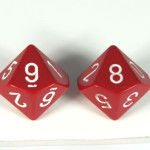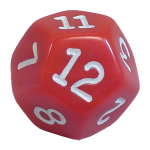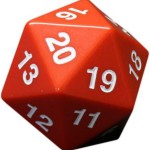In an effort to explain the significance of the different polyhedral dice, I came up with a game anyone can play with a simple set of 7 polyhedral dice.
Introduction
Each player has 7 dice:
| One 4-sided die (aka D4) |  |
| One 6-sided die (aka D6) |  |
| One 8-sided die (aka D8) |  |
| Two 10-sided dice (aka D10) |  |
| One 12-sided die (aka D12) |  |
| One 20-sided die (aka D20) |  |
The d20 is your chance die, and the other dice are your “damage” dice.
Lay them out in a row.
Ruleset 1 – Quick and Brutal Rules
Each player rolls their respective d20. Whoever rolls higher can roll whatever damage die they choose. If your d20 lands on 20, you roll the damage die 2 times. If your d20 lands on 1, your opponent rolls their damage die 2 times.
When you roll a damage die, you have 2 choices. If it’s as high or higher than an opponent’s damage die, you may strike that damage die from the board. You may also choose to simply hold the value, and not attack. When you attack next, add that value to whatever you roll. You may use that combined value to take out a damage die. Once you strike a damage die from the board, any accumulation of damage points is lost.
The game is won when you’ve struck all the opponent’s damage dice off the board.
Ruleset 2 – Traditional Rules
On your turn, you roll a d20. If the value is higher than 10 + opponent’s highest damage dice value divided by 2, you hit, and may roll whatever damage die you please.
So, for example, if your opponent still has their d12, then you must roll higher than 10 + 12/2, or 10 + 6… 16. If their highest die is a d10, then you must roll higher than 10 + 10/2, or 10+5… 15.
If you roll a 20, you can attack, then reroll the d20 to see if you can attack again. If you roll a 1, your opponent gets 2 d20 rolls against you (2 attacks of opportunity).
Ruleset 3 – Advanced Traditional Rules
Same ruleset as Traditional Rules, except you may now include your d4 with your d20 rolls. If the combined value of your d4 and d20 exceed your opponent’s max damage die value divided by 2, you get to attack. You can only do this 3 times per game. You may also roll the d20 and add a d6 to the value only once per game.
Optional Rule: Confirm the Crit
If you roll a d20, and it lands on a 20, roll the d20 again. If it lands on 11 or higher, the crit is confirmed, and you get the added benefit (rolling damage die twice, or being able to roll the d20 again for another chance to attack). If not, you lose the benefit, and you simply attack as normal. If you roll a d20 to attack, and it lands on 1, roll the d20 again. If it lands on 10 or lower, the critical failure is confirmed, and you suffer the consequences of that failure (either by the enemy getting 2 damage rolls against you, or by their getting another attack chance against you… depending on what rules you’re playing by).